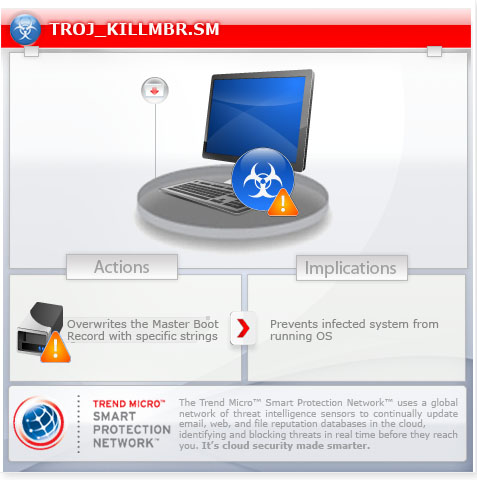TROJ_KILLMBR.SM
Windows 2000, Windows Server 2003, Windows XP (32-bit, 64-bit), Windows Vista (32-bit, 64-bit), Windows 7 (32-bit, 64-bit)


Threat Type: Trojan
Destructiveness: No
Encrypted:
In the wild: Yes
OVERVIEW
Downloaded from the Internet
This malware is involved in the Master Boot Record (MBR) wiper outbreak that targeted users in South Korea during March of 2013. It has a destructive payload that wipes the affected system's MBR. Users affected by this malware may find their systems freezing, shutting down, and unable to run.
To get a one-glance comprehensive view of the behavior of this Trojan, refer to the Threat Diagram shown below.

This Trojan may be dropped by other malware.
TECHNICAL DETAILS
Varies
EXE
Yes
20 Mar 2013
Others, Displays graphics/image
Arrival Details
This Trojan may be dropped by the following malware:
- TROJ_KILLMBR.DS
Process Termination
This Trojan terminates the following processes if found running in the affected system's memory:
- pasvc.exe
- clisv.exe
NOTES:
It overwrites the Master Boot Record (MBR) of the affected system with the strings PRINCPES or HASTATI. or PR!NCPES.
Overwriting the MBR prevents systems from loading the OS. It checks if the affected computer's system time is March 20, 2013 2:00pm or later. If the date is earlier, it remains dormant.
For Windows Vista and higher versions, it searches for all files in all folders and subfolders in all fixed and removable drives. It overwrites the files with a series of repetitive words and then deletes the files and folders. The files in the system root are the last to be overwritten.
For operating systems lower than Windows Vista, it overwrites the Volume Boot Record (VBR) of all fixed and removable drives.
It automatically restarts the system to let the infection take effect.
SOLUTION
9.300
9.804.03
21 Mar 2013
9.805.00
21 Mar 2013
Step 1
Restore your system's Master Boot Record (MBR)
To restore your system's Master Boot Record (MBR):
• On Windows 2000, XP, and Server 2003:
- Insert your Windows Installation CD into your CD drive then restart your computer.
- When prompted, press any key to boot from the CD.
- On the Main Menu, type r to enter the Recovery Console.
(Note for Windows 2000: After pressing r, type c to choose the Recovery Console on the repair options screen.) - Type the number that corresponds to the drive and folder that contains Windows (usually C:\WINDOWS) and press Enter.
- Type your Administrator password and press Enter.
- In the input box, type the following then press Enter:
fixmbr {affected drive} - Type exit and press Enter to restart the system normally.
• On Windows Vista and 7:
- Insert your Windows Installation DVD into the DVD drive, then press the restart button on your computer.
- When prompted, press any key to boot from the DVD.
- Depending on your Windows Installation DVD, you might be required to choose the installation language. On the Install Windows window, choose your language, locale, and keyboard layout or input method. Click Repair your computer.
- Select Use recovery tools that can help fix problems starting Windows. Select your installation of Windows. Click Next.
- If the Startup Repair window appears, click Cancel, Yes, then Finish.
- In the System Recovery Options menu, click Command Prompt.
- In the Command Prompt window, type the following then press Enter:
BootRec.exe /fixmbr - Type exit and press Enter to close the Command Prompt window.
- Click Restart to restart your computer normally.
Step 2
Before doing any scans, Windows XP, Windows Vista, and Windows 7 users must disable System Restore to allow full scanning of their computers.
Step 4
Scan your computer with your Trend Micro product to delete files detected as TROJ_KILLMBR.SM. If the detected files have already been cleaned, deleted, or quarantined by your Trend Micro product, no further step is required. You may opt to simply delete the quarantined files. Please check this Knowledge Base page for more information.
Did this description help? Tell us how we did.

